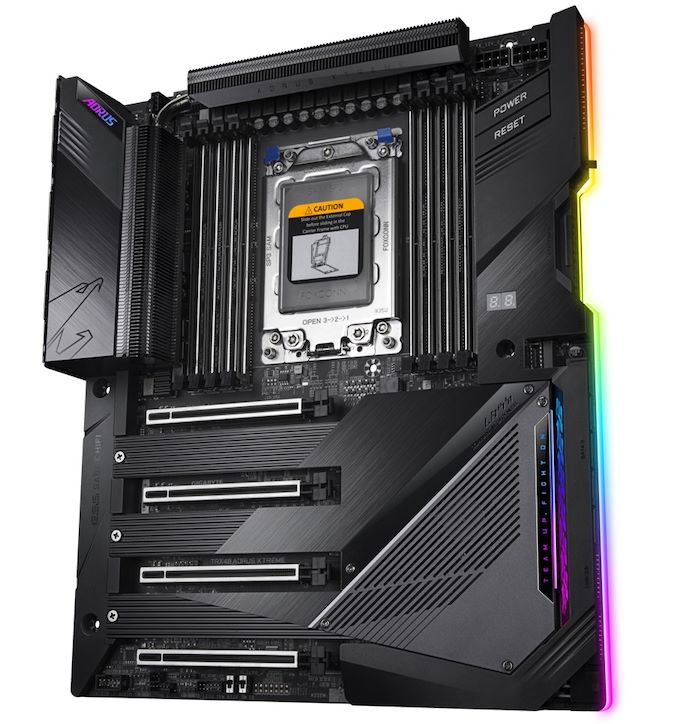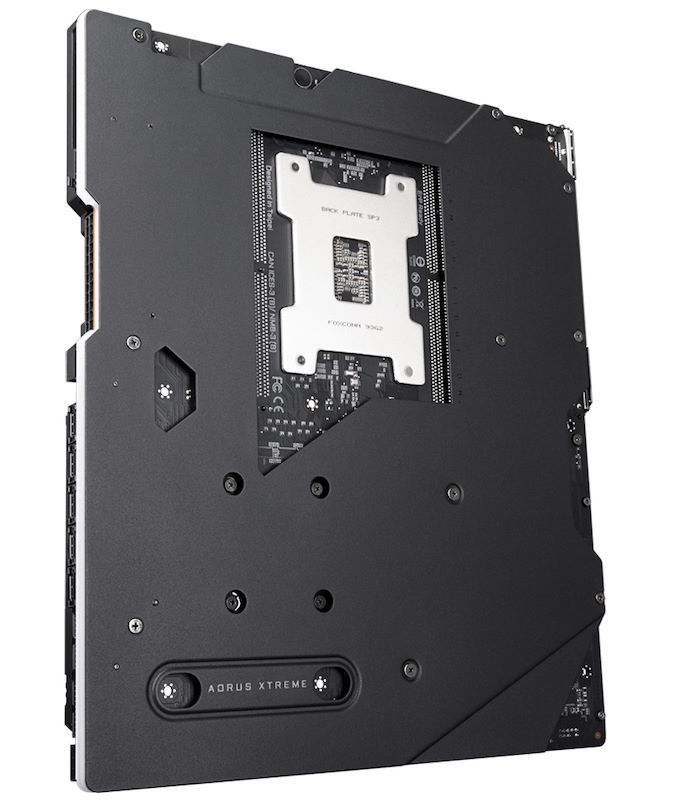The AMD TRX40 Motherboard Overview: 12 New Motherboards Analyzed
by Gavin Bonshor on November 28, 2019 9:00 AM EST- Posted in
- Motherboards
- AMD
- MSI
- Gigabyte
- ASRock
- Asus
- TRX40
- Threadripper 3000
- Castle Peak
GIGABYTE TRX40 Aorus Xtreme
To bolster the release of AMD's Threadripper 3000 series, GIGABYTE has unveiled the largest stack of all the vendors with a total of four new models. Three of GIGABYTE's TRX40 product stack flies the Aorus flag which is its gaming brand, with one model aimed more towards the professional user and content creators.
Starting with GIGABYTE's flagship TRX40 model, the GIGABYTE TRX40 Aorus Xtreme, it shows the potential of what to expect from AMD's new TRX40 chipset. The core feature set is impressive with an Intel X550-AT2 10 GbE dual-port Ethernet controller, an Intel AX200 Wi-Fi 6 wireless interface, and a total of four PCIe 4.0 x4 M.2 slots designed for super-fast NVMe PCIe 4.0 storage devices. Also bundled with the TRX40 Aorus Xtreme is an Aorus Gen4 AIC adaptor card which supports up to four 2 TB M.2 SSDs while benefiting from the bandwidth of PCIe 4.0.
The GIGABYTE TRX40 Aorus Xtreme is an XL-ATX motherboard and has a very unique and distinct look to it with a full coating of black metallic thermal reactive armor which covers the majority of the PCB. Integrated into the design is RGB LED lighting which is incorporated into the top of the rear panel cover, the right-hand side of the TRX40 chipset which features active cooling, and along the right edge of the board. A two-digit LED debug is moulded into the armor to the right of the memory slots, while a power and reset switch is placed just above. Focusing on memory support, the GIGABYTE TRX40 Aorus Xtreme has eight slots which are capable of supporting DDR4-4400 and up to 256 GB in quad-channel mode.
Underneath the rear panel cover and the large heatsink is the monolithic 16-phase power delivery which is controlled by the high-end Infineon XDPE132G5C true 16-phase PWM controller, with sixteen Infineon TDA21472 70 A power stages. This is similar to the design that we saw on the GIGABYTE X570 Aorus Xtreme model and in our testing, it proved to be one of the best and most efficient designs so far. The TRX40 Aorus Xtreme also has four full-length PCIe 4.0 slots which operate at x16/x8/x16/x8. For storage, there are four PCIe 4.0 x4 M.2 slots with its own M.2 heatsink, and a total of ten SATA ports; eight from the TRX40 chipset with RAID 0, 1, 10 support, and two SATA ports from an ASMedia SATA controller.
On the rear of the XL-ATX PCB is a full cover backplate which not only adds extra structural reinforcement to the rear but it also undoubtedly adds extra weight to the motherboard itself. Looking at the board from the rear allows us to see the right-angled 24-pin ATX motherboard power input, which is designed to make cable management look even cleaner. The GIGABYTE TRX40 Aorus Xtreme also includes an OC PEG power connector, an Aorus Gen4 AIC adaptor, and temperature sensor headers for the more extreme users. For cooling, there are seven 4-pin headers in total with one for a CPU fan, one for a water pump, and five for chassis fans.
On the rear panel is seven USB 3.1 G2 Type-A, and one USB 3.1 G2 Type-C port, which is a marked improvement on USB connectivity over the previous TR3 X399 models. To the left is a Clear CMOS button with a Q-Flash Plus button, with a pair of Intel AX200 Wi-Fi 6 antenna connectors and two 10 GbE ports powered by an Intel X550-AT2 10 GbE controller. For the onboard audio, there are two Realtek ALC4050H HD audio codecs with one paired up with a Realtek ALC1220 which powers the five 3.5 mm audio jacks and S/PDIF optical output on the rear, and another for the front panel audio which includes an ESS Sabre 9218 DAC.
The GIGABYTE TRX40 Aorus Xtreme is undoubtedly one of the flagship models on AMD's new Threadripper 3000 sTRX4 socket with a very high-end feature set, and very competent true 16-phase power delivery for the CPU. It's blend premium componentry and elegant stylings aren't going to come without a heavy hit to the wallet, with the GIGABYTE TRX40 Aorus Xtreme expected to cost $849.













109 Comments
View All Comments
Smell This - Thursday, November 28, 2019 - link
Still just a bit bummed .... that 1st/2nd Gen TRs have been left hangin'
As we roll into 2020, we gotta love where AMD is going BUT, here's hoping that Dr Su does not make the same mistakes on HEDTs that Chipzillah has been notorious in making in the past. With DDR5 on the horiZen, could sTRX4 be yet another *2 and Done* in the next 18 months?
I'm all for $800 mobos -- just as long as they don't become $50 moo-boards in January, 2021.
Spunjji - Friday, November 29, 2019 - link
Based on prior experience of AMD processors, it seems more likely that they'd have to offer new boards for DDR5 support but allow the new processors to run in older boards with DDR4.eek2121 - Friday, November 29, 2019 - link
Chances are that the TRX* series of boards will end in 2021 (or 2022 at the latest), when DDR5 is expected to roll out along with possibly Zen 5 (if 2022). That being said, I have an X399 board and a 1950X. I don't see a need to upgrade yet. I may eventually pick up a 2950X next year, but I'm hanging onto this platform. It games pretty much all current games at 4k, with the majority at maximum or high details (even on a 1080ti), and it's excellent for the development and content creation workloads that i do. Don't let the listed benchmarks fool you, the 1950X is capable of much more. Running Linux brings a rather large performance increase due to better thread scheduling among other things. I have no problems running GTA V or any other games that I play, at full 4k and maximum details.Llawehtdliub - Saturday, November 30, 2019 - link
At 30fpsscineram - Wednesday, December 4, 2019 - link
300.masmosmeaso - Thursday, November 28, 2019 - link
question,is the amount of phases important when it comes to performance or having more devices on the motherboard ? if so how many is overkill for these motherboards ?
Hul8 - Thursday, November 28, 2019 - link
Those power delivery components are only for the CPU package, and take all their power input from the auxiliary CPU power connectors (usually 8-pin, 8+4 or 8+8-pin these days).The rest of the motherboard get their power thru the 24-pin.
eek2121 - Friday, November 29, 2019 - link
More phases typically means better performance (thermals, quality of power, power limits) from the CPU, unless the vendor cheaps out on VRMs. I'd stay away from any board offering only a single 8-pin, as that can be a sign they are using lower quality VRMs, fewer phases, etc. Contrary to popular belief, phase doublers don't really hurt anything. A few in the youtube community have tested this, both with a CPU and also with a CPU 'emulator' that plugs into the socket and measures power output.Hul8 - Tuesday, December 10, 2019 - link
The question was about "devices on the motherboard", which I assume means things other than the CPU. That's why I pointed out that the phases are irrelevant to the question.Dragonstongue - Thursday, November 28, 2019 - link
just to say suchjust "cause" the box label as 280w TDP, this does not automatically mean it USES 280w (I am sure Intel or NVDA likely many many others) will lambast the crud out of AMD for this, without giving the "full story"
eg. Intel will say "our product X only is TDP of Y vs this massive 280w number, choose us, save the world" then when the user actually uses said "product X" they find out either A is much much slower than all review sites list it is and/or B, it shoots ACTUAL power use through the roof therefore not matching the "claims" of said product X TDP being "better" than TR gen 3 280w "listed" TDP
Intel, NVDA have far more proven themselves on "fibbing" their numbers to make the sales than AMD has "overall" over the many years I have been involved with (consumer or otherwise) in computing
............
Thanks for the review overall, at least it seems the various "partners" are not being overly foolish in terms of pricing and feature set, MSI IMO even "better" than some of the others (such as ASUS)
I truly hope these turn out to be the "cat's meow" for those whom can afford and use them, it helps AMD, helps their partners, the long run, helps us all
(^.^)